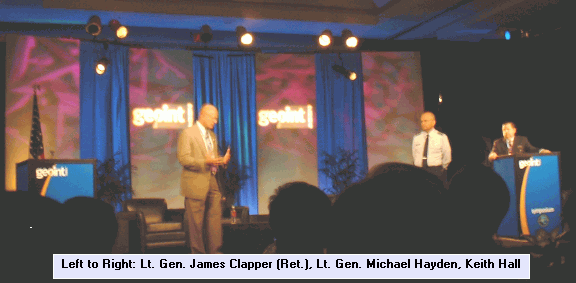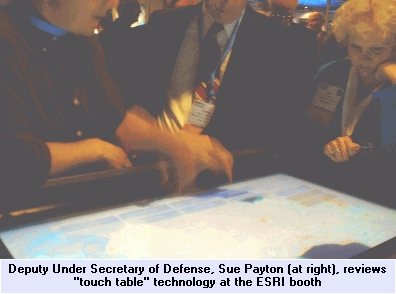
While coming home from GEOINT 2004 (Geospatial-Intelligence Conference - 2004), I was thinking about the events, presentations and the overall ambiance that seemed to be quietly embedded within this experience. This was more than just a Trade Show, a PowerPoint, or a conversation in the hall.
There were all heavy hitters presenting.The sign of a good conference is when it seems natural to hear from major players like George Tenet, (Former Director, Central Intelligence Agency), General James Clapper (Director, National Geospatial-Intelligence Agency), General Michael Hayden (Director, National Security Agency), Joan Dempsey (Exec.Director, President's Foreign Intelligence Advisory Board), and many others of similar status.Only on the way home did it really sink in that these are the people who are making the history of our time in the major conflict of our time.Not only from the point of view of the War on Terror or Homeland Security, but in the nature of technologies that will shape our industry.
The ambiance of the conference was really set by
the dynamic
duo of General Clapper and General Hayden.When they were on stage
together
talking about the nature of their roles, you could see elements of
Generals
from a previous time.In our time, the Generals will shape the outcome
of
events through intelligence, rather than battlefield strategies and
tactics.
These Generals were both combinations of Bradley, Eisenhower and
Patton.
General Clapper seemed to be more Patton and Bradley with a sprinkling
of
Eisenhower.General Hayden was a mirror of that combination with
perhaps the
bias toward Eisenhower and Bradley.Both were absolute compliments to
each
other.The reason these two men together on the stage was so
significant, was
they were shaping a level of cooperation between their agencies that
had not
been seen ever before in Government.The objectives were to make the
boundaries between their two agencies almost invisible.
This outward display of cooperation is not just
important for the future of how these two agencies work together, or
how they work in tandem with the Homeland Security Department.It is
significant because of the recognition that all
intelligence has a geographical component.The ability to be able to
access
that geography in terms of maps or imagery, and apply intelligence upon
that
geography is dependent on common standards and interoperability
protocols for imagery, map files and
related attribution.This can only be achieved through inter-agency
cooperation and
collaboration, and having the NGA as the pivotal agency for geospatial
information.
Note, as a frame of reference, the CIA (Central
Intelligence
Agency) is charged with HUMINT (Human intelligence), the NGA with
IMAGEINT
(Imagery and mapping intelligence), and NSA is charged with SIGINT and
ELINT
(Signal and Electronic intelligence).Geospatial processing puts each
source of intelligence in a common framework.Hence, GEOINT becomes the
common context by which all types of intelligence can be referenced.
General Clapper spoke about co-operational convergence.This is their vision of convergence of industry, NGA (National Geospatial-Intelligence Agency) and the NSA (National Security Agency). This was important because it allows the sharing of data and it includes the embedding of each of these three groups within a mission so that technological applications, innovations and adaptations could be tied directly to the mission itself for a heuristic experience for both people and systems.This collaboration cuts across all functions, both at the strategic and tactical levels.To make this work, it requires open standards for systems, the adaptations of legacy infrastructure and a perception of unity in the culture of intelligence.
Another aspect of the importance of cooperation,
convergence, innovation and adaptation is the understanding that NGA
really
collects nothing: they inventory, analyze and present.However, the
closer they
are to the source of collection, the more of the nuances can be
retained and
moved to the analysis and presentation.Intelligence is all about
nuance and
sometimes is almost existential (according to General Hayden) and
surreal in
the ability to understand what is happening or about to happen.
General Hayden's' first point was that U.S. intelligence is on the bleeding edge in the creation (collection), analysis and integration of information.They were way out in front of the competition, and they have to stay that way.In spite of the technology and infrastructure, the General identified that there are times when it requires "seven consecutive miracles" to glean an intercepted communication and move it to an actionable piece of intelligence.
General Hayden says, "Sharing at the product level was no longer adequate." The connections of data across the various disciplines (silos) are an imperative, if U.S.Intelligence was to have consistent "eureka moments" of intelligence enlightenment.The collective understanding would always be better than any one point in the process.Sharing had to begin at the point of collection.
General Hayden also identified that the current problems of collection were cultural, technological and existential. Cultural was the current organization (the entire intelligence community).How do we affect more cooperation and mutual understanding within this community? Technological was the most difficult problem, because of legacy processes and infrastructure that were not created to work together.Existential were issues of expectations, data quality, and usability, and even the problems of being able to work in the native language of the problem at hand.
An extremely important concept that NGA and NSA has developed is the GEOCELL: the integration of collection and analysis at the most tactical level.The objective was to get the best situational understanding to the most appropriate level, whether it was at the Division, the Regiment, the Brigade, the Company, etc., all in real-time or worst case, near real-time.A big part of enabling the GEOCELL was providing INTELLINK network access to those who needed it and moving the concept of intelligence from "The Need to Know, to The Need to Share".The GEOCELL includes personnel from NGA, NSA, other agencies and the relative vendors.
Sharing is now more important than in the past, when all of the intelligence agencies were siloed into discrete collection, analysis and presentation, not always sharing information or assessments.These silos let to duplication, conflicting assessment and, of course, a certain amount of empire building.Another factor of contemporary intelligence is that the level of requirements has moved from "mostly" right to 100% right.
These programs of cooperation and collaboration are part of the transformation that is changing the nature of the intelligence community. Any fundamental change within the government is always very difficult, complicated and a long-term process.But, these changes may be the very key in determining the ultimate effectiveness of a National Intelligence Director. Congress will determine the direction, while Generals Clapper and Hayden may have pioneered the actual process.
There were two things that cemented the ambiance of this conference in my mind.First, both General Clapper and General Hayden were very approachable people.None of the "Great I AM" that we have all seen with some people at high levels in the government.This was General Clappers' show and he was everywhere, just like General Bradley, the GIs' General, he was talking to the troops, the vendors, he was in all the presentations, he was getting demos on the trade show floor and you could even talk to him in the hallways or at the social events.
The second thing occurred at the social events on
Bourbon
Street.Directions Magazine Editor-in-Chief, Joe Francica, and I were
at a small table at one of the clubs, perhaps
at the House of Blues.There were lots of people, great food and music.
It
could have been any social event at any conference, except there was a
different undercurrent.The purpose of this conference was much
different.
People were here to create and apply the best Intelligence system in
the world.
In spite of the festivities, you could sense the same worried
excitement as
might have been at a diplomatic party in 1939 Paris or even an evening
at
Ricks' in Casablanca, only just a little more subtle.Everybody knew
why they
were there, and what it was about, they had just disguised it well and
made it
look like any other social gathering.
For more background, check out http://www.geoint2004.com